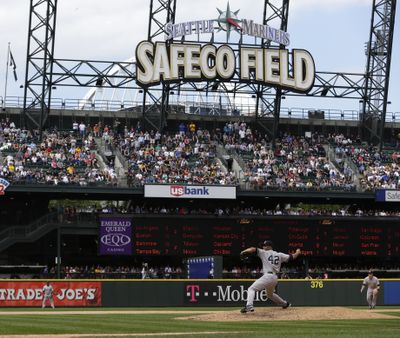Games at Safeco Field are shortest in the major leagues

CINCINNATI – Going to a baseball game in Seattle? Expect to see fewer pitches, fewer runs and a faster finish. Your tickets are for Fenway Park or Yankee Stadium? Make those dinner plans for a little later.
The average time of a major league game varies considerably from ballpark to ballpark, with one common thread: Scoring runs is entertaining, but it takes time. And with so many hitter-friendly parks around, those quick games have become an anomaly in some cities.
Not that everyone minds.
“I mean, if I am going to a ballgame – or at least when I used to go to ballgames as a kid – the longer the game was, the happier I was,” Tampa Bay manager Joe Maddon said. “I got to be at the ballpark longer.”
Whether young or old, no fans spend more time at a ballpark on average than those in Boston. Over the last five years, the average time of a nine-inning game at Fenway Park is 3 hours, 8 minutes, the longest in the majors, according to STATS LLC. Yankee Stadium is second at 3 hours, 5 minutes, followed by Miller Park and Coors Field at 3 hours even.
Fans at Safeco Field don’t sit in their seats as long. Nine-inning games there average 2 hours, 44 minutes, according to STATS. That’s a 24-minute difference from top to bottom.
A nine-inning game in the major leagues this season is taking 2 hours, 58 minutes, which would be among the highest averages if it holds for the season. Game times have been creeping up for years – nine innings took an average of 2 hours, 45 minutes in 1988, for instance.
There’s a correlation with offense.
The top four ballparks for runs scored since 2009 are among the top seven for length of game, according to STATS. There’s an average of 10.3 runs per game at Fenway – second-highest to Coors at 10.8 runs. Yankee Stadium features 9.8 runs.
All those runners crossing the plate add up to more pitches as well. Fans see an average of 299.7 pitches per nine innings at Fenway, most in the majors. Right behind are Yankee Stadium and Miller Park at 292.7 pitches, with Coors Field at 291.5.
“The more traffic (on the bases), the more time is taken between pitches to bear down and make sure you’re making your pitches,” Reds reliever Sam LeCure said.
In pitcher-friendly places, there’s more of an inclination to just let it fly.
“The park plays to our advantage, so our pitchers are more in an attack mode instead of having to be so fine with every pitch,” Mariners reliever Carter Capps said. “And they don’t make a lot of ‘waste’ pitches.”
Safeco and AT&T Park average 7.1 runs per game, fewest in the majors. Those two parks also have the quickest games on average – 2:46 at AT&T, 2:44 at Safeco.
Teams’ philosophies also play a role. Those that play in more pitcher-friendly parks can develop a style better suited to getting quick outs.
“Our team is built around pitching and defense, so you try to throw strike one,” Mariners bullpen catcher Jason Phillips said. “And, knock on wood, our defense has been pretty good. When we put the ball in play, we make the play. So there’s not a lot of errors and not a lot of long innings if the pitchers are keeping the ball down.
“Plus, with a bigger park – even with the fences moved in – the ball doesn’t carry very well and balls that seem to carry out of other parks are caught or stay in the ballpark.”
Runs are not the only factor. Television commercials can add a few minutes.
Games broadcast nationally on Fox, ESPN, TBS or MLB Network feature half-inning breaks of 2 minutes, 25 seconds – 20 seconds longer than a regular game. That adds up to more than 5 minutes for a game.